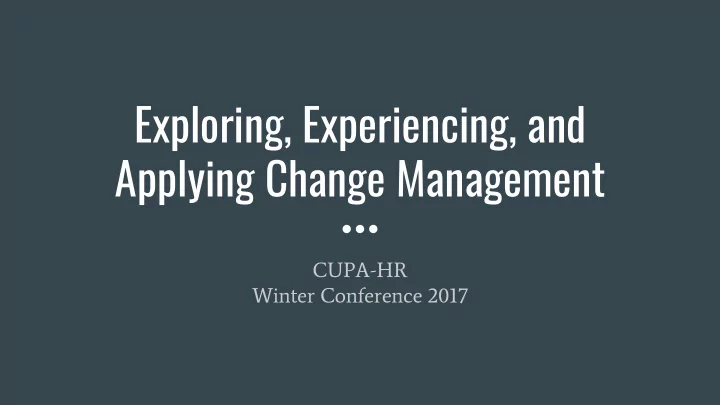

Exploring, Experiencing, and Applying Change Management CUPA-HR Winter Conference 2017
Agenda for today Define change management ● Brief history of CM ● ● Why CM is important How to apply CM ● Practice/Reflection ●
Project Management vs. Change Management Project management - the application of knowledge, skills, tools, and techniques ● to project activities to meet the project requirements ● Change management - the practice of applying a structured approach to transition an organization from a current state to a future state to achieve expected benefits You can see that project management focuses on the project and change ● management focuses on the process of getting people from present to future. https://www.pmi.org and http://www.acmpglobal.org
Change Management Timeline Lewin’s Change Theory - Unfreeze, Transition, Refreeze ● McKinsey 7-S Model - Shared values, Strategy, Structure, Systems, Style, Staff, ● Skills Kotter’s 8-Step Model - Creating a sense of urgency; Coalition-building; Creating ● Vision; Enlisting participation; Removing barriers; Fostering short-term wins; Sustaining acceleration; Instituting the change ● Prosci’s ADKAR and CM methodology and tools through ‘Professional Science’ http://www.quickbase.com/blog/three-types-of-change-management-models, https://www.kotterinternational.com/ and https://www.prosci.com/
Brains are Social Organs Neuroscience has demonstrated the brain is a ‘social organ’ - meaning social ● interactions lead to physiological and neurological reactions in the brain, and therefore the rest of the body Threat and Reward responses begin in the limbic system and can escalate into Flight or Fight ○ responses Recent research suggests threat responses are triggered in social interactions ○ Threat responses require oxygen and glucose, which means other parts of brain aren’t receiving the ○ fuel they need -- our ability to process new information, think analytically, solve problems, and be creative all suffer https://www.strategy-business.com/article/09306?gko=5df7f
Activity!
Reflection How did you feel? ● Did it come naturally or did you have to stop and think about it? ● ● What were you thinking about throughout the experience? How does this relate to change? ●
Change is stressful Familiar situations are comfortable -- ambiguity or confusion triggers a threat ● response ● Uncertainty takes mental energy, meaning the brain can’t perform other tasks as effectively So, how does this relate to change management? ●
Why Use Change Management? Remember, change management is the application of structured approach to ● transition an organization from a current state to a future state to achieve expected benefits - it can reduce uncertainty by helping members of the organization understand the plan and rationale for the change When members understand that there is a process in place to work toward a ● change, they can focus on the smaller, manageable steps along the way, rather than feeling overwhelmed by the overall change
Why Use Change Management? The use of change management can reduce the negative effects of cutback on ● employees commitment to their organization (Van de Voet and Vermeeren, American Review of Public Administration, Vol. 47, issue 2) Prosci’s research reminds us: ● Poorly managing change is costly ○ ○ Effective change management increases the likelihood of success http://journals.sagepub.com/doi/pdf/10.1177/0275074015625828 and www.prosci.com
Activity!
Reflection Identify 5 changes you’ve experienced in your life. ● For each change, consider: ● How did you handle the change? ○ What was challenging about the change? ○ How did others manage the change? ○ How were you affected by others’ reactions and what did you do about it? ○ Did you support others in managing the change? If so, how? ○
Discussion How can the changes you experienced in the past relate to new changes ahead? ● What is the most important lesson you learned from listening to others’ ● experiences and their responses?
How to apply Change Management IBM’s ‘Making Change Work’ study analyzes the behaviors of Change Architects ● and determined they: ○ Lead at all levels - everyone needs to be involved Make change matter - state the vision, objectives, and benefits clearly ○ ○ Build the muscle - centralize change management with formalized change expertise https://www-935.ibm.com/services/us/gbs/bus/html/gbs-making-change-work.html
How to apply Change Management Prosci’s research suggests the following are essential for successful change ● initiatives: ○ Active and visible executive sponsorship Structured change management approach ○ ○ Dedicated change management resources Integration and engagement with project management ○ ○ Employee engagement and participation Frequent and open communication ○ ○ Engagement with middle managers www.prosci.com
Tying Change Management to Project Management Does your organization have change managers on staff? If not -- what role can you ● play in facilitating change or encouraging your organization to incorporate CM? ● Consider the who of the change Who are the stakeholders (How will each level of the org be affected?)? Who are the leaders? Who ○ are the early adopters? Who will be the anchors? State the why of the change ● How will people understand what is happening? ● Create a plan for when to include people in the change - when to disseminate ● information, provide training, etc.
Applying Change Management
Final Reflection and Next Steps What is your big takeaway from this session? ● What do you want to know more about? ● ● What steps can you take to learn more? What do you commit to do to foster effective change management in your ● organization?
Additional Resources Prosci Thought Library: ● https://www.prosci.com/change-management/thought-leadership-library ● Change Management: The People Side of Change, Hiatt & Creasey, 2012 ADKAR: A Model for Change in Business, Government, and our Community, ● Hiatt, 2006 The Effective Change Manager: The Change Management Body of Knowledge, ● Change Management Institute, https://www.change-management-institute.com/sites/default/files/uploaded-conten t/field_f_content_file/cmbok_sample.pdf Stakeholder Mapping Activity: https://workshopbank.com/stakeholder-mapping ●
Denée Janda denee.janda@colorado.edu
Recommend
More recommend